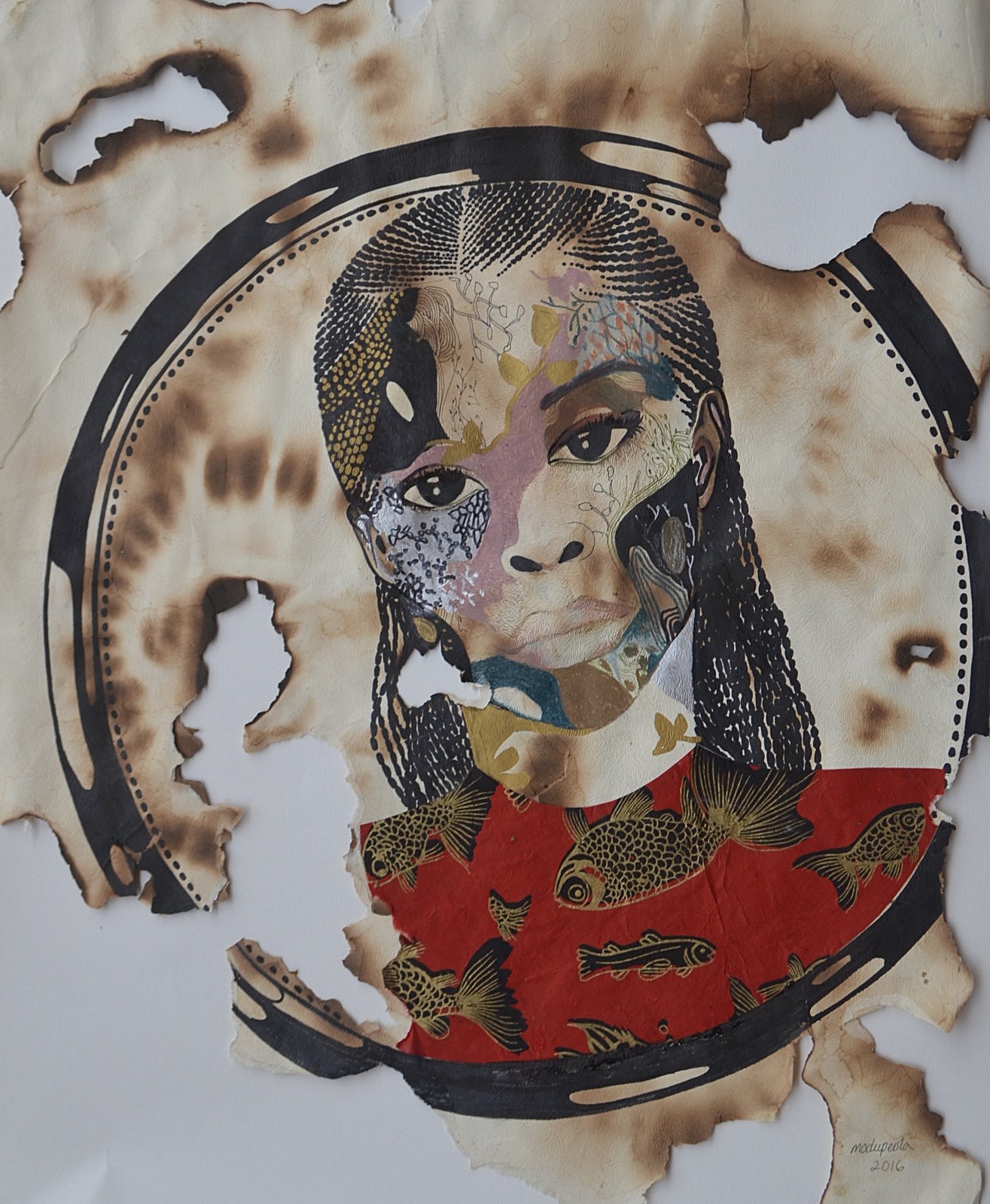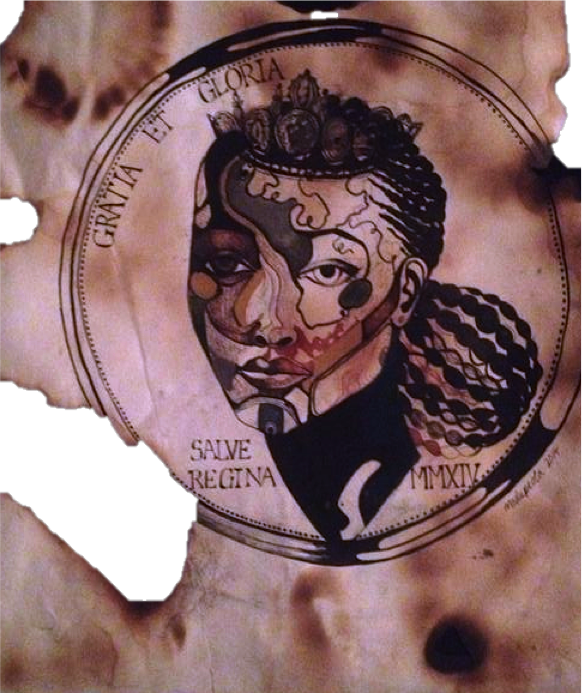heads or tails (2014 - 2017)
My paintings examine related issues through a more deliberative, self-reflexive process. In Heads or Tails (2014–2017), I adorn painted coins with the faces of young Nigerian women, reversing social hierarchies that historically have portrayed only men on monetary objects. This series uses currency as a symbol of disruption and a metaphor for probing themes of value and worth, particularly as they relate to wider gender structures in Nigeria. In this alternative universe, braids replace tiaras and black women are represented as things of value. Since we seldom use coins in many African nations, I paint these women on paper notes. And to reflect the ever-declining value of many of our currencies, in patches, holes and sections, I let the paper burn.
Of all the elaborate patterns, symbols, inscriptions, and mottos on the American dollar bill, one of the most curious is Annuit cœptis. These Latin words come from the Great Seal of the United States, and appear on the note’s obverse, hanging diadem-like above the unfinished pyramid with the Eye of Providence at its peak. The US Mint translates Annuit cœptis as “He [God] has favoured our undertakings,” and the United States’ official motto—“In God We Trust”—emblazoned across the centre of the bill leaves no doubt as to God’s supreme presence. Yet the original Latin could be more accurately translated as “our undertakings have been favoured”; there is no direct mention of God, no certainty as to who is bestowing the favour. Once noted, this discrepancy becomes troubling. For those who trust in God in the first place, can they really be sure that he is always watching over them? Is he truly omnipotent, or are our undertakings sometimes a game of chance? And if we don’t trust in God, who guides and uplifts our everyday actions, if anybody?
Modupeola Fadugba approaches these questions as an artist, seeking not certainties but insights, connective threads, and pathways to more questions. Dollar bills were her first introduction to the United States, a country she emigrated to with her parents at the age of five, and the themes of value and worth, particularly as they relate to wider social systems and structures, have assumed a central role in her practice. Having grown up with colourful Togolese francs, the green American banknotes were something of a mystery to her, and led her to believe that America itself would be green-tinted too, a vision that despite its naïveté speaks powerfully of the imbalances—or perhaps the tonal variations— that come with the circulation and unequal distribution of money. As the text and symbolism of the dollar bill remind us, such matters cannot easily be disentangled from questions of faith, trust, and chance; currency, then, is a potent metaphor for probing these issues further.
In the series Heads or Tails (2014–2016), Fadugba considers the role of chance and value in determining the course of our lives. The series consists of several painted paper coins that vary in size and are rendered on almost-square paper, the smallest measuring around 50cm on each side and the largest around nine times that size. Each coin features a black female face encircled by a beaded rim. The faces are not identical, but share many characteristics: full lips, high cheekbones, and sumptuous eyelashes. Hair blossoms from their heads in elaborate braided styles. Some of them gaze straight out, while others glance off to the side, although whether through distraction or boredom is hard to say. The individuality of each is further suggested by the surfaces of their skin, which are painted as delicate layers of colourful organic forms. Enhancing these complexities is the paper itself, which has been burnt in patches, leaving holes edged by dark scorch marks that contribute both mystery and melancholy, and create a subtle surface on which Fadugba’s painted female figures emerge and dissolve.
The coin toss is a recurring theme in Fadugba’s work, signposting her preoccupation with luck and human agency. It first occurs in The People’s Algorithm (2014), an interactive game installation where players may be asked to spin a larger-than-life coin and learn their destiny. In this work, Fadugba seeks to highlight the agency of Nigeria’s population in addressing its own social issues. She has remarked that the religiosity of many Nigerians is both their great strength and their weakness; in embracing their own ability to make transformations in their lives, instead of relying only on God, she believes there is potential for greater empowerment and change for the better.
In Heads or Tails, Fadugba returns to this theme, but with rather different results. Instead of the participatory, multifaceted game scenario developed in The People’s Algorithm, Heads or Tails offers a more traditional, directional viewing experience. In choosing the faces of young black women to adorn her coins, Fadugba turns currency into a symbol of disruption and upends social hierarchies that have throughout history placed white men as the default figures represented on monetary objects, particularly in the United States. Instead of a straightforward substitution, however, Fadugba proposes a game of chance with a different starting point, that considers how black women perceive themselves and their worth. She has reflected, “In the beginning of time, if Eve came first and Adam was created from her rib, or if light was bad and dark was good, our perception of gender and colour might be different. Maybe the Black woman would have been heads and the White man tails.” Yet historically this has clearly not been the case, and we are left pondering an unresolved tension between chance, on the one hand, and on the other, the deliberate construction of inequality by those who seek to benefit from it.
The deeper intrigue of this series lies in the fact that viewers can quite literally only see one side of the coin. In naming it Heads or Tails, Fadugba implies the existence of two possible outcomes to any coin toss, but in showing only heads, she indulges her playful instincts as well as the question of fate. In what kind of world is the result always “heads”? In such a world, what might “tails” look like? When currency circulates, to what extent does it perpetuate power disparities which result in certain people and places occupying the “head” of any situation, while others bring up the rear? We are left considering these questions under the gaze of Fadugba’s enigmatic faces.
Dr. Evelyn Owen















